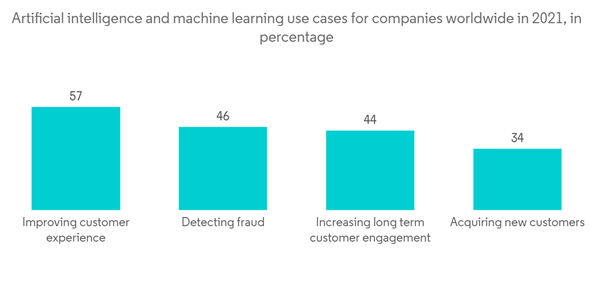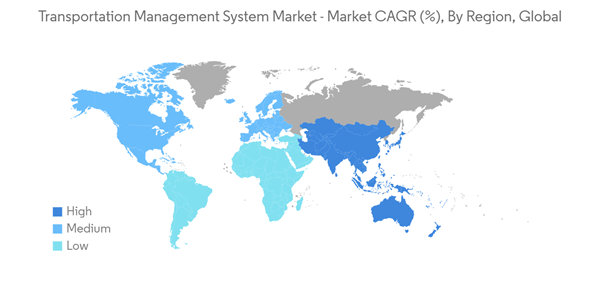The growing trend toward utilizing TMS by retailers and logistics companies and increasing backhaul support services for reverse logistics are extensively driving the market's growth.
Key Highlights
- One of the most recent trends gaining pace is the integration of advanced technology, including blockchain and artificial intelligence, to improve the capabilities of transportation management systems. Additionally, the adoption of sophisticated transportation management systems is fueled by the growing preference for cloud-based, anti-theft GPS and IoT-enabled systems to ensure transparency and security. The introduction of AI-enabled self-driving trucks and the overall ongoing rollout of 5G networks are expected to significantly affect the transportation sector and create new market opportunities.
- For instance, recently this year, BluWave-ai declared the introduction of version 2.0 of the BluWave-ai EV Fleet Orchestrator with the support of USD 1.7 million in co-funding from FedDev Ontario. This software-as-a-service (SaaS) product supports vehicle fleet operators as they can electrify their operations. These operators involve last-mile delivery, municipal mass transit, corporate vehicle fleets, airport ground support, and various electric vehicle (EV) fleet operations. Moreover, the EV Fleet Orchestrator also lowers the overall cost of operations and carbon footprint for fleet operations with mixed battery electric and fossil fuel vehicles operating from buildings, depots, or regional networks of depot/hubs due to its built-on BluWave-ai's established AI energy optimization platform and leveraging its technology IP portfolio.
- Further, nowadays, retailers are inclining toward omnichannel systems that incorporate brick-and-mortar, online, mobile, catalog, and other sales channels under a single umbrella. That increases freight transportation, and TMS helps increase visibility to all shipments under one user's control. This visibility allows for better business decisions when making transportation decisions.
- However, the shortage of experienced professionals and higher implementation costs with higher maintenance costs are a few factors expected to hinder the market's growth during the forecast period.
- The COVID-19 pandemic has had a severe impact on new sales and installations. The market's expansion was constrained by lockdowns and the limitations on the movement of people and goods implemented to stop the spread of the virus, resulting in changes in consumer behavior and interruptions in the supply chain. Nevertheless, the surge in the overall usage of innovative solutions based on advanced technologies and the increasing significance of various data-driven solutions in transportation and logistics are anticipated to contribute to the market's growth.
Transportation Management Systems (TMS) Market Trends
Increasing Use of Cloud and Artificial Intelligence in Supply Chain Management
- Industry landscapes are evolving rapidly primarily due to the wide adoption of artificial intelligence (AI), which includes computer vision and machine learning (ML) technology. The adoption of AI solutions and services is anticipated to be augmented by the need to achieve robotic autonomy to remain competitive in a global market. The market for artificial intelligence is expanding across the globe as a result of the growth of data-based AI and advancements in deep learning.
- The growing trend of multi-cloud functionality and the expanding demand for cloud-based intelligence services are boosting the market's overall growth. Modern AI tools add new and increased value to cloud computing. This factor is essential for incorporating new technologies within the sector, improving process viability overall. AI software also helps close the technological gap between modern breakthroughs and cloud computing.
- Consequently, since the AI cloud facilitates the convergence of two technologies, AI software and hardware, cloud computing and artificial intelligence are well combined in an AI cloud hybrid system. It helps to create a cloud environment similar to the human brain. Hence, the businesses functioning in the market are widely adopting and using AI through the cloud delivery of AI software-as-a-service., enabling them to utilize AI capabilities.
- For instance, recently this year, Oracle announced that it would open up its ERP applications platform to customer developers and partners. It also unveiled new B2B commerce services and declared a wide variety of additions to its supply chain management (SCM), enterprise planning management (EPM), and human capital management (HCM) Fusion Cloud offerings.
- As per Algorithmia, in 2021, the top use cases for artificial intelligence and machine learning were for increasing customer experience, i.e., 57%, whereas the total share for generating customer insights/intelligence was around 50%; detecting fraud stood at about 46%. That indicated a vast scope of benefits associated with the various use cases for artificial intelligence and machine learning. Hence, with the rise in the adoption of artificial intelligence, the market is expected to witness significant growth opportunities throughout the forecast period.
Asia-Pacific to Witness Fastest Growth
- Asia-Pacific is expected to witness the fastest growth rate due to the increasing international trade, particularly in emerging economies like China and India. Also, factors like the rapid pace of e-commerce growth, a complex mix of investment drivers, global trade, manufacturing growth (Made in China, for instance), and new infrastructure operations are expected to provide various lucrative market growth opportunities in the region.
- In the Asia-Pacific region, smartphone penetration is increasing, along with increasing disposable income. These factors support the growth of e-commerce in the region. India is another region that can be considered a significant and emerging market for TMS vendors; it is currently experiencing increased investments from shippers and third-party logistics (3PL) providers, thus providing scope for transportation technologies and TMS applications. Therefore, a proper TMS will be required to cater to the maximum number of customers. This will provide increased opportunities for the TMS market.
- The Asia-Pacific region creates unique challenges for organizations operating in the area. Some of the challenges include multiple languages and currencies, complex trade agreements (like the United States and China), regulations and compliance/legal requirements, varied economic conditions, developing infrastructure, and the increasing importance of green and sustainable transportation. The presence of these challenges throughout the region is augmenting the market's growth significantly.
- According to Boeing, by 2037, China plans to have around 740 freighters in its cargo airplane fleet; it had only 170 freighters in 2017. Therefore, with such an increase in freighters, the need for TMS will also increase. TMS can dramatically reduce complexity by integrating fleet and logistics management throughout the network. Also, China is considered the third largest transportation market after the United States. With its growing economy, high levels of urbanization, and proliferation in the e-commerce industry, China is estimated to be a significant contributor to the TMS market, despite the considerable number of Chinese companies already using TMS.
- Moreover, Sensata, an electronics company with operations spread across 12 countries, including China, Japan, Korea, and Malaysia, initially managed its transportation in a silo, with very little transportation network visibility and even less collaboration among the company's various locations. In the first quarter of this year, the company unveiled the Sensata | Xirgo OTAC (Over the Air Charging) Tracker Solution, which enables customers to securely charge and store up to about 400 compatible asset trackers at once per charging station to manage assets where permanent attachment or external power is a challenge. Fleet operators and large retailers with shipping yards and distribution centers are the perfect candidates for the solution since they can save money by expediting the deployment and charging of asset trackers.
Transportation Management Systems (TMS) Industry Overview
The transportation management system market is moderately competitive. Due to rapid industrialization, this market has enormous potential to grow. Therefore, vendors are started to target untapped smaller companies, fueling the industry to penetrate every corner of the business. Some key players are Oracle Corporation, SAP SE, and Cerasis Inc., among others.In June 2022, Descartes Systems Group, the industry pioneer in bringing together logistics-intensive enterprises in commerce, announced the acquisition of XPS Technologies, a supplier of multi-carrier parcel shipping solutions for e-commerce. Through this acquisition, all the small, medium, and large-sized e-commerce shippers can directly access XPS' cloud-based multi-carrier parcel shipping solutions.
In May 2022, the largest independent provider of TMS, MercuryGate International Inc., announced a partnership with Amazon Freight, an Amazon-powered freight delivery service. The MercuryGate platform would give shippers access to Amazon Freight's reliable network and affordable dynamic pricing.
Additional Benefits:
- The market estimate (ME) sheet in Excel format
- 3 months of analyst support
This product will be delivered within 2 business days.
Table of Contents
Companies Mentioned (Partial List)
A selection of companies mentioned in this report includes, but is not limited to:
- 3Gtms Inc. (Sumeru Equity Partners)
- CargoSmart Ltd
- Descartes Systems Group Inc.
- Manhattan Associates Inc.
- JDA Software Group Inc
- Oracle Corporation
- SAP SE
- Precision Software Inc. (QAD Inc)
- MercuryGate International Inc (Summit Partners)










